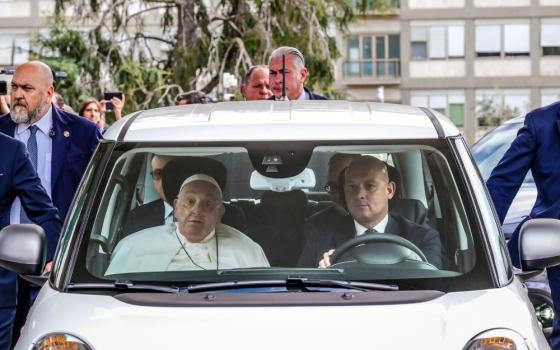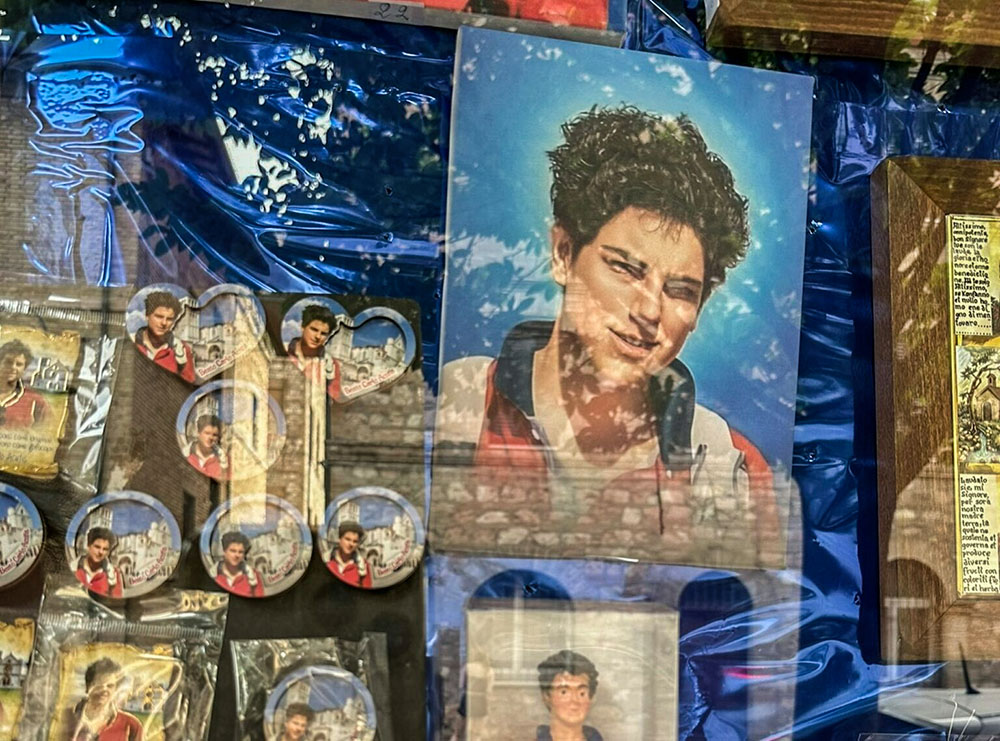
Carlo Acutis souvenirs are displayed in a shop window in Assisi, Italy, in June 2023. (RNS/Michael Di Giovine, CC BY)
The Italian teenager Carlo Acutis, who died in 2006 of a rare form of leukemia at age 15, will soon become the Catholic Church's first "millennial saint."
Acutis was a computer programmer who created virtual exhibitions and databases on eucharistic miracles — when the bread and wine are believed to change into the physical body and blood of Jesus — and reported sightings of the Virgin Mary. Although the specific date has not been announced, the Vatican indicated that his canonization will occur in 2025 when the church celebrates its jubilee, or holy year that occurs every quarter century.
Canonization is the official term for declaring a person a saint. It requires the verification of a faithful life through an often lengthy research process. This includes confirming two miracles.
Acutis' first miracle involved a Brazilian child who could not eat solid food because of a pancreatic disorder, but was inexplicably healed in 2013 after praying to the teenager. The second involved a Costa Rican student who, after suffering a head injury, awoke from her coma after her mother prayed at Acutis' shrine in 2022.
The bishop of Assisi, Italy, described Acutis as an "ordinary" teenager with extraordinary faith. Acutis' upcoming canonization reflects the Vatican's interest in making a more modern church that appeals to a new generation of faithful.
This is a trend that began at the turn of the millennium with another charismatic saint, Padre Pio of Pietrelcina — one of the world's most prayed-to saints — whose devotion I've studied for over a decade.
Padre Pio: 'Saint for the millennium'
Born in Pietrelcina, Italy, in 1887 and originally named Francesco Forgione, the Capuchin Franciscan priest was hailed by the Vatican as a "saint for the millennium" when he was canonized in 2002. Pio was arguably the first saint of the 21st century to speak to the culture of the time.
A poor friar, Pio was believed to have had the stigmata, or bleeding wounds of Jesus' crucifixion. Considered a living saint, he reportedly had mystical visions of Jesus and could know beforehand what people came to confess.
Advertisement
In his lifetime, Pio used devotees' donations to set up a research hospital at the shrine in San Giovanni Rotondo, Italy, to couple medical healing with spiritual healing.
When he died in 1968, the Italian air force dropped flowers on his funeral procession, which was attended by an estimated 100,000 people. His 2002 canonization ceremony had a record 300,000 attendees.
His extraordinary veneration in 2008-2009 drew upward of 9 million pilgrims to the town of San Giovanni Rotondo. That year, he was exhumed and exhibited before being moved into a new ultramodern basilica designed by globally recognized architect Renzo Piano and adorned with work from leading contemporary artists.
In 2016, Pope Francis brought Pio's body to Rome to be the centerpiece for his special Jubilee Year of Mercy. Tens of thousands watched his procession through the city of Rome to the Vatican.
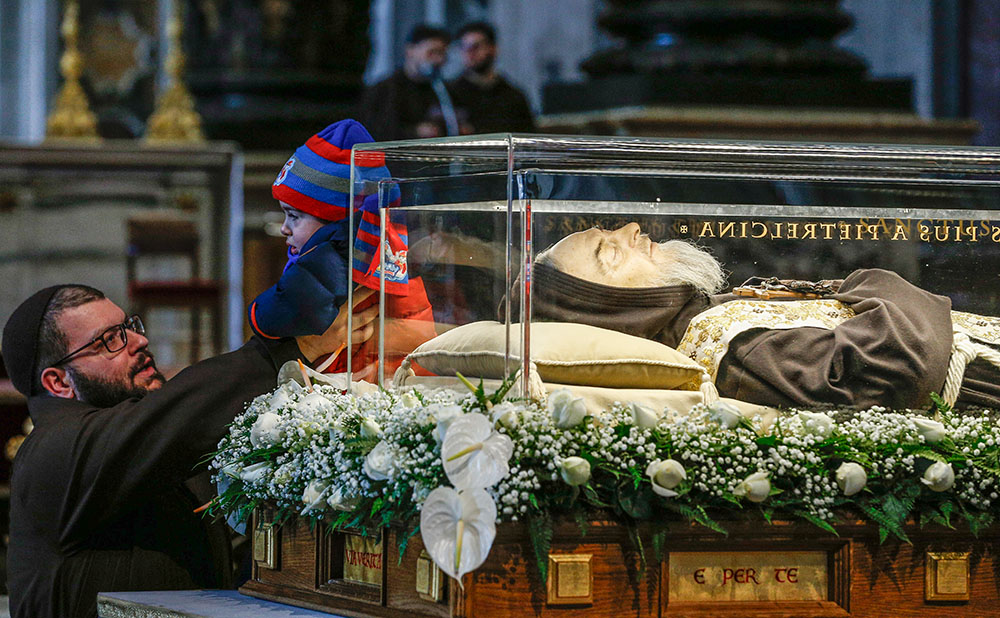
A child is lifted to come into contact with the glass case containing the body of St. Padre Pio in St. Peter's Basilica at the Vatican Feb. 6, 2016. Pio's body was brought to Rome at the request of Pope Francis for the Year of Mercy. (CNS/Paul Haring)
Pio's "rock star" popularity was — and continues to be — fueled by global media that includes multilingual magazines, a publishing house, a radio station, a satellite TV station and a website, which together net the shrine more than US$150 million per year.
Such modern media was rare for the turn-of-the-millennium, but were considered necessary for circulating photos and videos of his stigmata, something people had to see to believe.
Acutis: An everyday saint
Yet as Pio's devotees get older, the church seems to be turning to Acutis to appeal to a new, more worldly demographic.
Like Pio, Acutis enjoys widespread appeal among a new generation in search of contemporary models of holiness, according to journalist Rhina Guidos, who interviewed Latin American teens in 2023. The appeal of Acutis lies in being an ordinary person who models everyday faith — whom Pope Francis calls a "saint next door."
What sets Acutis apart from other saints is that "none of these individuals thus far have used cellphones, played PlayStation videogames, or searched for information on Google," writes Fr. Will Conquer in his biography of Acutis, A Millennial in Paradise. Indeed, the media is already lauding Acutis as "God's influencer" and the "patron saint of the Internet."
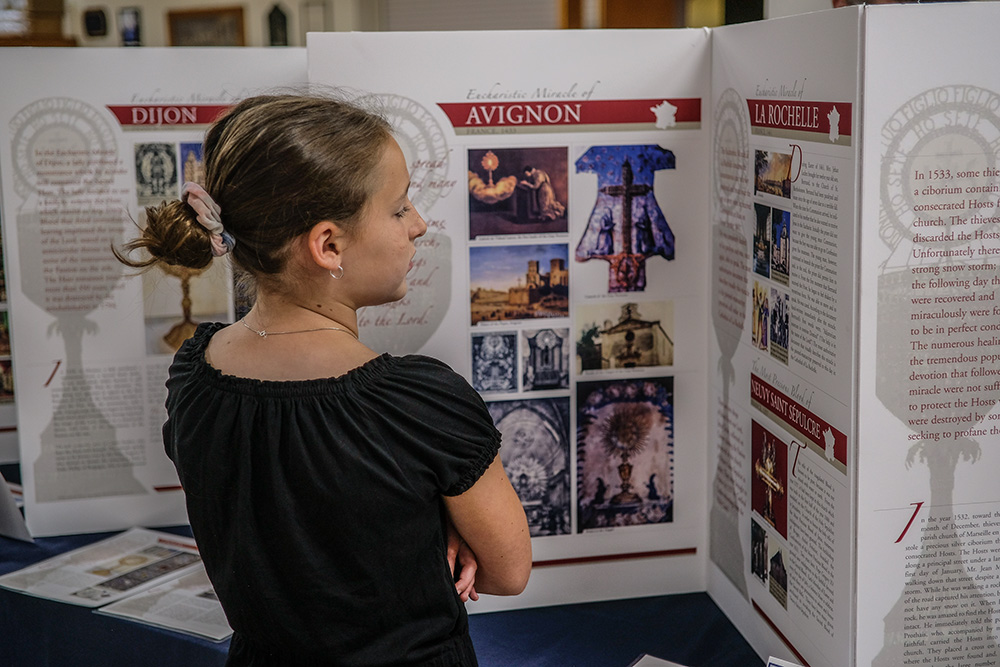
At Immaculate Conception Church in Clarksville, Tennessee, in July 2023, Giavana Hoefler, 10, looks over an exhibition created and designed by Blessed Carlo Acutis that explains every eucharistic miracle documented around the world. The 156-poster display has miracles listed across 20 countries and witnessed by multiple saints and beatified individuals. (OSV News/Tennessee Register/Katie Peterson)
In January 2024, Francis urged young people to use their modern, everyday interests for the church as Acutis did: "Since he was very good at getting around on the internet, he used it in the service of the Gospel, spreading love for prayer, the witness of faith and charity toward others."
His story is also marketed through media the new generation uses, especially TikTok, Instagram and YouTube. His biographies take the form of comics or young adult novels. Biographies with titles such as A Saint in Sneakers and God's Computer Genius mix stories of his holiness with discussions of his love of Nutella and struggle with weight, his interest in soccer, hiking and searching for information on Google, and his passion for Pokémon and Halo video games.
His online exhibitions also have gotten an old-school makeover: A physical version has been created and is exhibited in parishes throughout Europe and the U.S. — a way to bridge younger and older generations. Located in Pennsylvania, the Malvern Retreat House, one of the oldest and largest spiritual centers in the U.S., boasts a permanent exhibition of Acutis' eucharistic miracles in its Blessed Carlo Acutis Shrine and Center for Eucharistic Encounter.
A modern pilgrimage
On his deathbed, Acutis asked to be buried in Assisi — the birthplace of St. Francis, the founder of the Franciscan religious order and the patron saint of Italy — since Acutis was attracted to the saint's teachings.
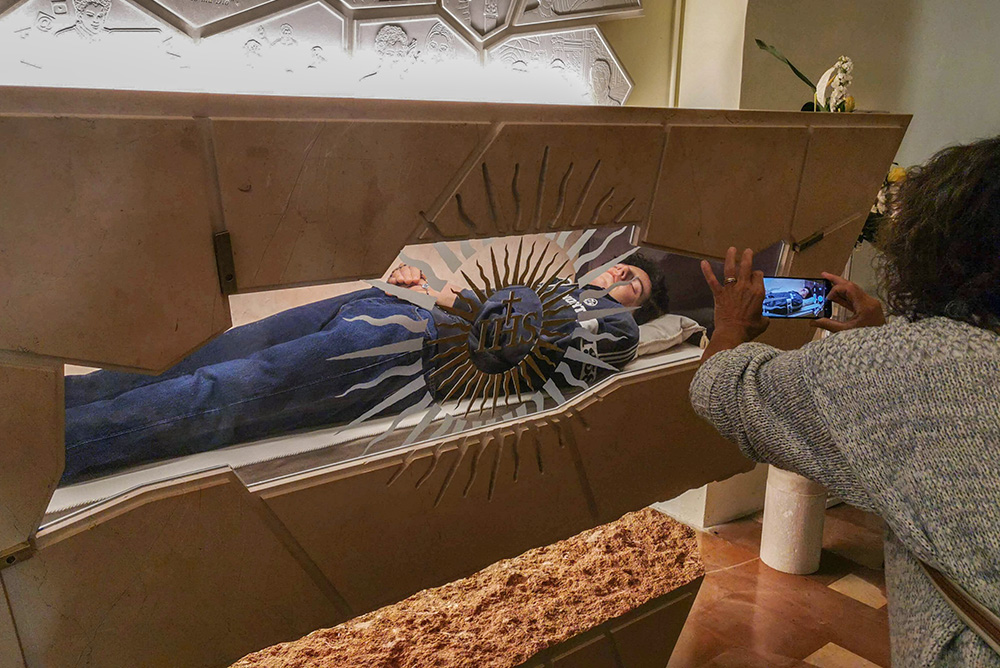
A woman takes a smartphone image of the body of Carlo Acutis in the Church of St. Mary Major in Assisi, Italy, Oct. 9, 2020. (CNS/Junno Arocho Esteves)
Acutis was first buried in a cemetery in Assisi, but once his canonization process opened in 2019, his body was exhumed and dressed in jeans and sneakers; it was placed in a modern, see-through sarcophagus in the small church of the Sanctuary of the Spoliation in a little-visited area of the town.
That next year, 2020, more than 117,000 pilgrims visited despite COVID-19 pandemic restrictions, according to the Assisi Diocese. The sight continues to be popular; when I visited in June 2024, long lines of people, especially children, from as far away as the United States and Sri Lanka were lining up for a chance to pray at his tomb.
Indeed, the town of Assisi has enjoyed a makeover of sorts, thanks to Acutis. A modern chapel holding Acutis' heart was created in Assisi's cathedral, San Ruffino. He is given equal billing as St. Francis in guided tours. Even souvenir stands incorporate a modern look, as ubiquitous images of St. Francis now share space with key chains, photos and pictures of Acutis in jeans, Adidas and a backpack.
Acutis is continuing the trend started by the Catholic Church with Pio's sainthood to modernize devotion. As a perpetual "teenager in heaven," laid to rest in Nikes, jeans and a warm-up jacket, a tech-savvy and socially conscious generation of young Catholics may very well see themselves in him.

